Re-evaluation of Fermi’s theory of beta-decay
Physics
DOI:
https://doi.org/10.14331/ijfps.2018.330112Keywords:
Fermi’s beta-decay, Neutron quark model, Neutron distribution, Jefferson Lab (JLAB)Abstract
Another published paper of the author proposes that proton and neutron radii have contraction inside the atomic nuclei, generating a discrepancy of 8s between the neutron lifetime measured in beam and bottle experiments. According to the present theory, the neutron radius in beam experiments dilates from 0.26fm up to 0.87fm during the initial 8s, after which begins the process of decay. The present paper proposes a new neutron model with quark structure d(u-e-u), with an electron sandwiched between two up quarks. It reproduces very well all neutron properties, as for instance the radial charge distribution, impossible to be reproduced considering the current quark model ddu. So, the radial charge distribution of neutrons (obtained from beam experiments, if measured in the first initial 8 seconds of their lifetime) has to exhibit a curve a little different of that measured in 2007 in the Jefferson Lab. Here is proposed to JLab to repeat the experiment under such new condition.
Downloads

Published
How to Cite
Issue
Section
License
Copyright (c) 2020 International Journal of Fundamental Physical Science

This work is licensed under a Creative Commons Attribution 4.0 International License.










